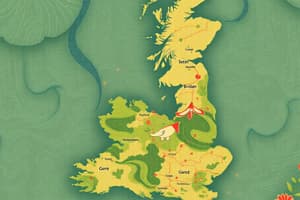Podcast
Questions and Answers
What does the physical aspect of geography primarily focus on?
What does the physical aspect of geography primarily focus on?
- Cultural differences
- Weather patterns
- Landforms and water bodies (correct)
- Historical events
Which of the following is NOT considered a landform in geography?
Which of the following is NOT considered a landform in geography?
- Rivers (correct)
- Valleys
- Mountains
- Plateaus
How does the study of elevation and topography influence human settlement patterns?
How does the study of elevation and topography influence human settlement patterns?
- It has no impact on human settlement
- It solely influences the geological history of the planet
- It determines the type of vegetation in an area
- It affects climate and vegetation, which in turn influence settlements (correct)
Which term refers to the long-term patterns of temperature, precipitation, and wind in a region?
Which term refers to the long-term patterns of temperature, precipitation, and wind in a region?
How do water bodies like oceans influence climate patterns?
How do water bodies like oceans influence climate patterns?
What is the main purpose of understanding climate patterns?
What is the main purpose of understanding climate patterns?
How can understanding the El Niño Southern Oscillation (ENSO) benefit farmers in Chile and Peru?
How can understanding the El Niño Southern Oscillation (ENSO) benefit farmers in Chile and Peru?
What do cultural landscapes help us understand?
What do cultural landscapes help us understand?
Which tool allows geographers to analyze, store, and visualize spatial data?
Which tool allows geographers to analyze, store, and visualize spatial data?
Why is geography considered a vital field of study?
Why is geography considered a vital field of study?
Study Notes
Exploring Our World: A Primer on Geography
Geography — the study of Earth's lands,features, and people — invites us to delve into the fascinating complexities of our planet. From understanding landscapes and climate patterns to examining cultural differences and demographic shifts, geography enriches our understanding of our world and its interconnectedness.
The Lay of the Land
The physical aspect of geography focuses on the study of Earth's surface, including landforms, elevation, and water bodies. Landforms, such as mountains, plateaus, and valleys, shape our landscapes and provide insights into the geological history of our planet. The study of elevation and topography, like slope and aspect, reveals how these factors influence climate, vegetation, and human settlement patterns.
Water bodies, like oceans, lakes, and rivers, play a crucial role in shaping Earth's surface. These water bodies not only provide habitats for a diverse array of flora and fauna but also influence climate patterns, global currents, and trade routes.
Climate and Weather
Geography is also deeply intertwined with climate and weather. Climate refers to the long-term patterns of temperature, precipitation, and wind that characterize a region. In contrast, weather denotes the short-term conditions experienced at a specific location and time.
Understanding climate patterns helps us predict the distribution of plant and animal species, assess the vulnerability of ecosystems, and anticipate the impacts of climate change. For instance, understanding the El Niño Southern Oscillation (ENSO) and its effects on precipitation can help farmers in Chile and Peru better prepare for drought or flooding.
Human Geography
Human geography, also known as cultural geography, examines the spatial distribution of human activities, demographics, and cultural practices. This subdiscipline of geography helps us understand how and why people form patterns of settlement, trade, and communication.
Some key topics within human geography include population distribution, urban and rural development, and cultural landscapes. Population distribution, for instance, reveals insights into patterns of migration, urbanization, and resource utilization. Urban and rural development helps us better understand the economic, social, and environmental factors that shape urbanization. Cultural landscapes, meanwhile, provide a way to understand how people have shaped and transformed the physical environment to meet their needs and desires.
The Tools of Geography
Geographers use a variety of tools and techniques to explore our world. These tools include maps, satellite imagery, geographic information systems (GIS), and remote sensing.
Maps, for instance, provide a succinct overview of the spatial distribution of geographic features, landforms, and human activities. Satellite imagery offers an extensive view of the Earth's surface, revealing patterns and changes over time. Geographic information systems (GIS) allow us to analyze, store, and visualize spatial data, while remote sensing helps us observe and measure the Earth's surface from a distance.
Geography: A Vital Field of Study
Geography provides a unique perspective on the complexities of our planet, offering insights into the relationships between environment, people, and space. By studying geography, we not only expand our understanding of our world but also acquire the skills to solve global challenges, such as climate change, sustainable development, and resource management.
Geography is a dynamic and engaging field of study, providing opportunities for exploration, research, and innovation. By delving into geography's insights, we not only gain an appreciation for our planet's boundless beauty but also develop the knowledge and skills to tackle the challenges that lie ahead.
Studying That Suits You
Use AI to generate personalized quizzes and flashcards to suit your learning preferences.
Description
Test your knowledge on the fundamental aspects of geography including physical features, climate patterns, human activities, and tools used in geographic exploration. Explore Earth's lands, cultures, and interconnectedness through this engaging quiz.




